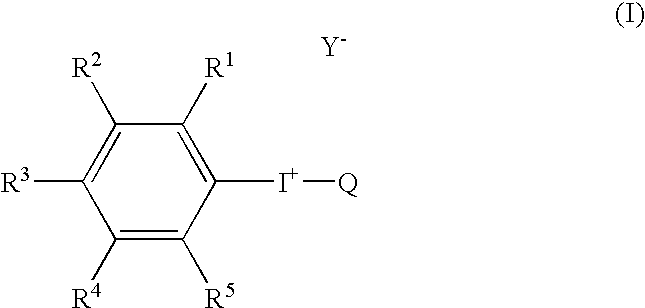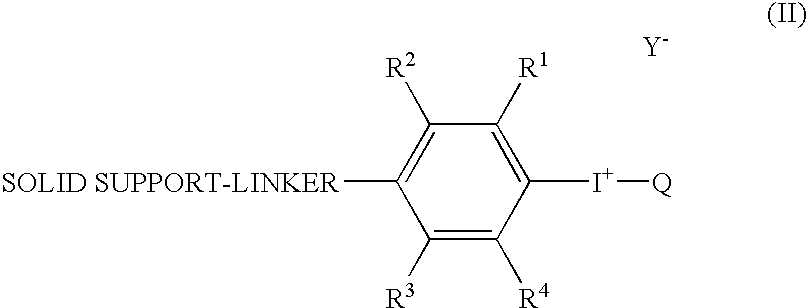Radical trap in fluoridation of iodonium salt
a technology of iodonium salt and fluoridation method, which is applied in the field of radiochemistry, can solve problems such as the problem of problematic use of iodonium salts in the synthesis of [sup>18/sup>f] aryl fluorides
- Summary
- Abstract
- Description
- Claims
- Application Information
AI Technical Summary
Benefits of technology
Problems solved by technology
Method used
Image
Examples
example 2
Fluorination of diphenyliodonium triflate in the presence of 2 mol % TEMPO
[0047]
ReagentsMwtmmolesWeightVolumePotassium fluoride580.15.8 mgDiphenyliodonium4300.143 mgtrifluormethane sulphonateD3-acetonitrile1 mlKryptofix 2,2,2.376.50.137.6 mg(4,7,13,21,24-Hexaoxo-1-10-diazabicyclo[8,8,8]hexacosane)2,2,6,6-tetramethylpiperidine1560.0023.12 mgN-oxide radical (TEMPO)
Experimental
[0048]The method of Example 5 was repeated with the addition to the reaction mixture of TEMPO (3.12 mg, 0.002 mmol).
Results
[0049]From these NMR experiments it was clear that fluoride ion reacts immediately with the iodonium salt to give a compound which is completely different from the trifluoromethane salt. This is identical to the previous reaction without TEMPO. The reaction was relatively stable at room temperature but slowly reacts. On heating the reaction the complex formed on mixing was converted to a mixture of fluorobenzene and iodobenzene.
Conclusion
[0050]The NMR data indicated that the first step of the...
example 3
Radiofluoridation of diphenyliodonium triflate in the presence of 50 mol % 1,2-DPE
[0057]The same reaction as described in Example 3 was carried out in the presence of 50 Mol % of 1,2-DPE.
[0058]The RCP and RCY values obtained are presented in the table below:
[0059]
Reaction NoRCPRCY356437
example 4
Radiofluoridation of (2-methyl-4-methoxyphenyl)phenyliodonium trifluoroacetate in the presence of 93 mol % TEMPO
[0060][18F]-fluoride in 18O enriched water (˜0.4 ml) was loaded into the reaction vessel, to this was added a mixture of a solution of Kryptofix (17.9 mg, ex Sigma-Aldrich Chemicals) in acetonitrile (1 ml) and potassium carbonate (0.2 ml of a 0.1 M aqueous solution). The fluoride was dried by azeotropic drying. Following the completion of the drying process, a solution of (2-methyl 4-methoxyphenyl)phenyliodonium trifluoracetate (21.2 mg) and TEMPO (ex Sigma-Aldrich Chemicals) (7.8 mg) in acetonitrile (1 ml) was added to the dry fluoride. The mixture was heated at 95° C. for 15 minutes before being cooled in a stream of compressed air. The product was transferred to a sealed collection vial and the reaction analysed by HPLC.
[0061]The RCP and RCY values obtained are presented in the table below:
[0062]
Reaction NoRCPRCY368552376345
PUM
| Property | Measurement | Unit |
|---|---|---|
| temperature | aaaaa | aaaaa |
| volume | aaaaa | aaaaa |
| reactivity | aaaaa | aaaaa |
Abstract
Description
Claims
Application Information
 Login to View More
Login to View More - R&D
- Intellectual Property
- Life Sciences
- Materials
- Tech Scout
- Unparalleled Data Quality
- Higher Quality Content
- 60% Fewer Hallucinations
Browse by: Latest US Patents, China's latest patents, Technical Efficacy Thesaurus, Application Domain, Technology Topic, Popular Technical Reports.
© 2025 PatSnap. All rights reserved.Legal|Privacy policy|Modern Slavery Act Transparency Statement|Sitemap|About US| Contact US: help@patsnap.com



